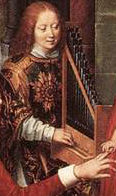

There are no surviving examples of portative organs. There are however many representations of such organs in medieval paintings. One set of images that provide enough detail to make a modern copy are the well-

Memling Portative Organ




There are no surviving examples of portative organs. There are however many representations of such organs in medieval paintings. One set of images that provide enough detail to make a modern copy are the well-

Memling Portative Organ

